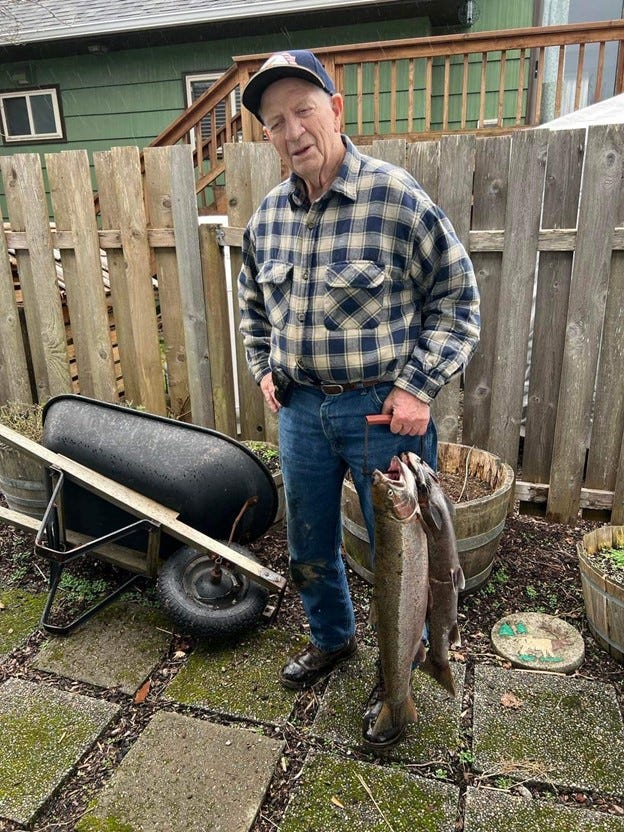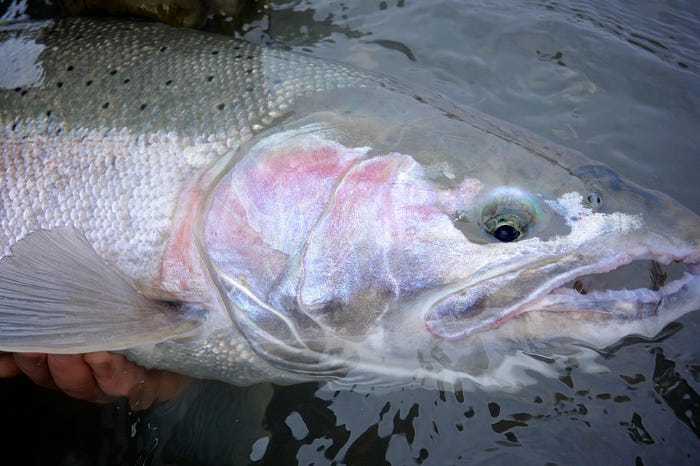
What comes next for coastal steelhead
With the 2022–2023 seasons recently announced, we thought we’d take the time to summarize some of our progress so far in support of coastal steelhead sustainability and what the future could hold for these fisheries.
Final seasons
Chances are if you’re reading this, you may have tuned in to one of several virtual town halls we held this fall, shared a comment during staff updates to the Washington Fish and Wildlife Commission, or logged on for one of our Ad-Hoc Coastal Steelhead Advisory Group meetings. This extensive public engagement process ultimately helped to shape the 2022–2023 coastal steelhead fishery, which includes some additional late-season coho opportunities and increased opportunity to fish from a boat.
The season is structured similarly to prior year’s fishery, particularly in the Hoh River and the Willapa Bay tributaries.
Fishing opened on the Hoh River and Willapa Bay tributaries Dec. 1 and will continue through March 31 with selective gear rules, including single point barbless hook. Fishing from a floating device will be prohibited. There is a hatchery steelhead bag limit of two, and anglers must release wild rainbow trout.
The Quillayute River System will follow similar rules as the prior year’s emergency regulations, aside from expanded boat fishing in the Sol Duc River. Fishing from a floating device is allowed in the mainstem Quillayute and below Maxfield boat ramp on the Sol Duc River, below the Highway 101 bridge on the Calawah River, and downstream of the mouth of Mill Creek on the Bogachiel River which is about 3/4 mile above the Bogachiel Hatchery.
Sport fishing closed in sections of the Quinault and Queets rivers managed by WDFW beginning Dec. 1 through April 30 due to chronic low wild steelhead abundance and failure to reach agreement on an acceptable level of wild steelhead harvest.
WDFW continues to pursue agreement with tribal co-managers through signed fishery management plans in these systems. WDFW will announce any progress toward signed management plans this fall and winter.
Please visit the Olympic National Park webpage for information on fishing closures for the Queets, Salmon, and Quinault rivers within the Park.
Portions of the Humptulips and Chehalis rivers opened Dec. 1 to Dec. 16 to provide opportunity for coho salmon fishing while supporting steelhead conservation objectives.
For more information, reference the WDFW emergency fishing rule change webpage and our recent news release.
Our vision for the future
This winter, we also released the final Coastal Steelhead Proviso Implementation Plan. Consistent with existing Department policies, the plan intends to advance steelhead fishery management of Grays Harbor, Willapa Bay, and the coastal Olympic Peninsula river systems.
WDFW developed the plan in response to the Legislature’s 2021–23 budget proviso following declines in coastal steelhead population viability and associated reductions in angling opportunities.
The plan includes guidelines and information about recreational fishery regulations, monitoring and evaluation, hatchery operations, habitat restoration, and economic vitality at coastwide and river-specific scales. It also provides budget projections needed for successful implementation, identifies research critical to advancing management, and details communications tactics to enhance public awareness about coastal steelhead management.
WDFW’s Ad-Hoc Coastal Steelhead Advisory Group, which met publicly throughout 2022, was actively involved in all stages of the plan development process. WDFW also fine-tuned elements of the plan in response to public input received through an online public comment portal throughout 2022 and a public comment period the Department held this fall following the release of the draft plan.
To reference the Coastal Steelhead Proviso Implementation Plan, visit WDFW’s website.
Pending funding from the Legislature, WDFW anticipates plan implementation will begin in the summer of 2023, preceding the 2023–2024 coastal steelhead season. The plan lays the foundation for the development of Regional Management Plans, which would include long-term coastal steelhead conservation objectives, an approach for evaluating fishery management strategies, and mechanisms for monitoring, among other elements, in collaboration with tribal co-managers.
WDFW continues to operate under its Statewide Steelhead Management Plan, which requires the Department to prioritize the sustainability of wild coastal steelhead runs by focusing on healthy levels of abundance, productivity, diversity, and distribution.
The Coastal Steelhead Proviso Implementation Plan also aligns with the Department’s Anadromous Salmon and Steelhead Hatchery Policy and Joint Co-manager Hatchery Policy, should it be approved by the Commission.

An emphasis on monitoring
In the near-term, WFDW is implementing some increased monitoring for the 2022–2023 coastal steelhead fisheries to help to inform fishery decisions in the future.
This includes the use of:
· Guide logbooks:
Guides and charter boat operators are integral parts of our fishing communities. They introduce people to fishing, advocate for public access to our natural resources and bring millions of dollars in tourism into Washington’s local communities. WDFW recognizes this value the industry brings and has a long history of partnering with the guide community to support robust fisheries management.
In 2019, the Fish and Wildlife Commission passed a rule initiating logbook reporting by guides to collect additional data on species encountered, locations fished and the number of anglers fishing with guides. This tool will be integral to improve communication between the agency and the fishers that spend the most time on the water. The agency developed three reporting tools to help guides comply with the new rule: a paper logbook, a web reporting application and a mobile reporting application.
The logbook is one of the most direct tools that guides have at their fingertips to help support fisheries monitoring and inform fisheries management. As compliance with the mandated logbook goes up, so does the value of this tool for helping to provide critical in-season monitoring. Learn more about the guide logbook on our website.
· Creel surveys:
We have a team of staff who is continuing to conduct creel interviews to talk directly with anglers. These in-the-field conversations help fishery managers to get a sense of how the run is doing in-season, the number of fish kept and released by anglers, and can provide valuable information about fish size, genetics, age, and condition to better inform future fisheries management.
· Test fishing:
New this season, the Department is hiring two seasonal staff to implement a test fishery, an exercise intended to mimic the real-life fishery, to gather vital data to inform WDFW’s knowledge of the fishery and steelhead run size. Staff will be using a variety of gear types in a wide array of setting — hiking along the river, using boats, and even joining local fishing guides — where fisheries are open to get a better glimpse into fishery data. This information is intended to complement and build upon other monitoring metrics the Department is gathering this season. It will also provide additional opportunity to collect important information about fish size, age, and genetics.
· Tribal data sharing:
Data from tribal co-managers is an integral part of fishery monitoring.
The Department is also exploring other monitoring options for coastal steelhead, including sonar (short for sound navigation and ranging), Passive Integrated Transponder (PIT) tag arrays, and increased rotary screw trapping, going forward.
Future monitoring investments are also outlined in the Coastal Steelhead Proviso Implementation Plan, pending legislative funding.
Where available, tribal net schedules for coastal rivers are posted on this webpage.

Lake fishing opportunities
WDFW staff have also been hard at work this season stocking surplus adult hatchery steelhead in Cases, Radar and Black Lake in Pacific County with potential for future stocks in Borst, Inez and Sylvia ponds in the coming months. Planted fish will feature a tag along their dorsal fin with a number to a WDFW fish biologist, who will be tracking the success of the program.
The additions are part of an ongoing effort give anglers an opportunity to harvest surplus hatchery steelhead with minimal to no impacts on wild fish.
Learn more about fishing opportunities about these and other lowland lakes on the WDFW website.
Stay engaged with coastal steelhead management
Thank you for your continued interest in coastal steelhead. To learn more about coastal steelhead management or share a question or comment directly with WDFW fishery managers, visit the WDFW website.
